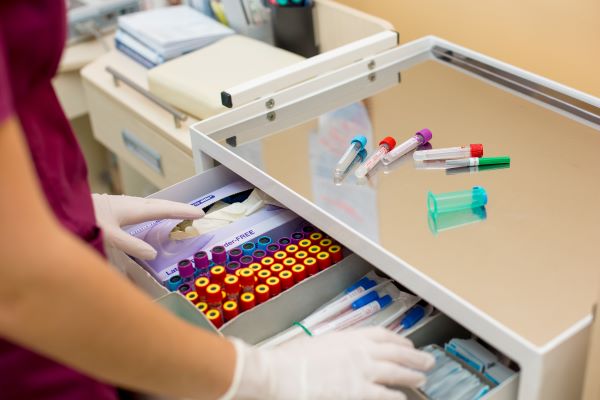How to ACE the order of Draw
Any phlebotomist who is preparing to draw someone’s blood knows the importance of the order of draw. They also know the dangerous ramifications that could adversely affect the patients’ health if the order of draw is not followed properly.
What is the order of draw?
Remembering the order of draw is one of the hardest tasks for even the most seasoned phlebotomist. What is the order of draw actually? Well in a nutshell, every lab test that a physician orders must go into a different color tube. Each of these tubes has an additive, although there may be some tubes without additives. An additive is a chemical which prevents the blood from clotting until the phlebotomist can get it to the lab. So, what is with all the different colors? A vacutainer tube is the name of the tubes that the phlebotomy technician uses to collect blood. It would follow that the needle would be called a vacutainer needle. The interesting component of the vacutainer needle is the hub needle which punctures the tops of the vacutainer tubes. We are now one step closer to explaining the order of draw. You see, it is this hub needle that can become contaminated with the additive at the bottom of the tube once blood begins to flow into the tube.
If for some reason the phlebotomist does not use the correct order of draw, then the hub needle will continue to deposit additives into the consecutive tubes which will then adversely affect the lab test results. This can be anything from excessively elevating sodium, potassium or calcium.
For these reasons we have the order of draw. Some phlebotomist use a mnemonic to help them remember.
Blog Market Lab shared some very humorous mnemonics, such as “Studious Boy’s Rarely Get Low Grades” referring to Sterile, Blue, Green, Lavender and Grey. Then we have the mnemonic for cheese lovers, Brie (Blood Culture), Limburger (Light Blue), Ricotta (Red), Gorgonzola (Green), Leyden (Lavender), and Gouda (Gray): Cheese lovers shouldn’t have a hard time with this list — except for maybe limburger, which is definitely an acquired taste! The only problem you might have with this memory tool is lusting for your lunch.
Big Picture
While it may seem fun to memorize cute mnemonics, it is more important to understand the battery of tests used for each vacutainer, because some hospitals have different orders of draw. This knowledge is what separates a good phlebotomist from an amazing phlebotomist. The best way to always remember tubes is by additives. This way, no matter how many times a hospital may change the color of the tubes, the additives will always remain the same. The amazing phlebotomist will always know the order of the tubes based upon the additives and the division of lab where the tubes of blood are delivered.
We have listed the following tubes and their order of draw as well as their department:
• Blood cultures: nutrient medium/ or acid citrate dextrose/Microbiology
• Light blue: Sodium Citrate/ Coagulation
• Serum Separator Tubes: no additive or thixotropic gel/Serum Chemistry
• Dark Green: Sodium Heparin/ Serum Chemistry
• Light Green: Lithium Heparin/Serum Chemistry
• Lavender: Potassium (2) EDTA or K2EDTA/ Hematology
• Pink: Potassium (2) EDTA or K2EDTA/Blood Bank
• Royal Blue: Potassium (2) EDTA or K2 EDTA/ Toxicology
• Grey: Sodium Fluoride + Potassium Oxalate/ Urine Chemistry/Glucose Testing
What comes next?
Now the phlebotomist must commit to memory the tests associated with each department. This task is not as hard as it looks. For instance, Serum Separator Tube tests will always be one of the following: enzymes, proteins, vitamins, hormones, electrolytes, ions, and immunoglobulins. They will also be divided into body systems such as: hepatic or liver, thyroid, lipids or cholesterol, renal or kidney and metabolic profiles. While the red serum separator tubes are used for medications or waste tubes.
Next, we have the green tubes for all the above-mentioned tests that are ordered, “stat”, or immediately. Then comes hematology. This is quite easy since any test that looks at the red cells, white blood cells, thrombocytes or hemoglobin will always be in the lavender top tubes. Interestingly, both the lavender and the pink tubes share the same additive and also are part of hematology just different departments.
Summing it all up
If the phlebotomy technician knows the order of draw based upon the above criteria, they will always Ace it every time. Being a phlebotomist can be a fun as well as demanding profession. Those who have the skill, desire and compassion can help patients every day. Part of the phlebotomist’s scope of practice is to collect optimal samples of blood. To do this they must be proficient in knowing the order of draw. So even if you like the mnemonics, be sure to know what goes into each tube and what department it is associated with and you will be the best phlebotomist ever!

Nancy L. Kimmel obtained her PhD in Environmental Engineering in 2002, then went on to teach Physics and Mechanical Engineering at Lawrence Technological University, Henry Ford College and Oakland University. She obtained her Associate in Nursing from Henry Ford College and then went on to earn her Master Degree as a Family Nurse Practitioner and became Board Certified working as a licensed FNP in the State of Michigan. She then went on to Medical School where she is now in her 3rd year, and is also in the process of obtaining her Doctorate in Nursing Practice through Chamberlin University. She has authored the NET Study Guide, as well a several books on subjects of Math, ECG/EKG and Phlebotomy. She holds a patent on an Air Filter through the U.S. Patent Office.


